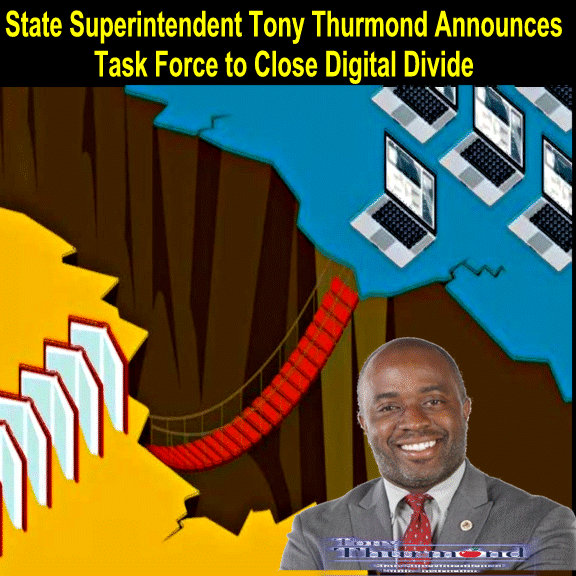Thurmond Announces Digital Divide Task Force - Year 2020 (CA Dept of Education)
State Superintendent Tony Thurmond Announces Task Force to Close Digital Divide
SACRAMENTO—State Superintendent of Public Instruction Tony Thurmond announced today the creation of a new task force to close the digital divide for California students who lack access to resources such as internet connectivity and devices. The Closing the Digital Divide Task Force will be co-chaired by California State Senator Connie Leyva.
“This task force signals a new era, that California is now working with focus and urgency to close the digital divide in the most concrete way we have ever seen,” said Thurmond. “COVID-19 is a public health crisis in California and all around the world, but it’s also revealed other crises like the technology gap that has persisted for too long, leading to opportunity and achievement gaps for California’s students.”
“As the Chair of the Senate Education Committee, I strongly believe that ensuring equity for California students is critically important,” said Senator Connie M. Leyva (D-Chino). “One vital step to ensuring equity is by closing the digital divide, which has become that much more evident and urgent as distance learning is now the new reality for millions of school children during the current COVID-19 crisis. I look forward to co-chairing this important task force as we all continue to work together to meet the needs of students in California.”
The Closing the Digital Divide Task Force will help facilitate donations, create more publicity, and cast a bigger spotlight on those who can help. It also plans to hold a public hearing where internet service providers may be called upon to testify on their efforts to improve internet access during the pandemic.
The California Department of Education (CDE) has in recent weeks assessed the technology needs for all California students and is working with partners to secure devices and Wi-Fi hotspots to close the technology gap. This effort comes following a strong recommendation last month from State Superintendent Thurmond for all schools to focus on distance learning models due to the COVID-19 health crisis.
The CDE also announced last week that it partnered with the Californians Dedicated to Education Foundation (CDE Foundation), the private non-profit partner of the CDE since 2011, to create the California Bridging the Digital Divide Fund. The fund is a joint effort of the Governor’s Office, State Board of Education, CDE, and CDE Foundation, and is a centralized resource for state leadership to provide essential device, connectivity, and related digital learning supports for pre-K-12 students, teachers, and their families.
The fund is focused particularly on building more equitable teaching and learning environments, which are currently in even greater jeopardy due to the uneven impacts of COVID-19 on students, families, and educators. This includes special attention to special education, English learner, low-income, and rural populations, for which additional virtual educator professional learning webinars are now in development.
# # # #
Tony Thurmond — State Superintendent of Public Instruction
Communications Division, Room 5602, 916-319-0818, Fax 916-319-0100
Thurmond Announces Digital Divide Task Force - Year 2020 (CA Dept of Education)




















